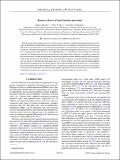Resource theory of non-Gaussian operations
Author(s)
Zhuang, Quntao; Shor, Peter Williston; Shapiro, Jeffrey H
DownloadPhysRevA.97.052317.pdf (628.8Kb)
PUBLISHER_POLICY
Publisher Policy
Article is made available in accordance with the publisher's policy and may be subject to US copyright law. Please refer to the publisher's site for terms of use.
Terms of use
Metadata
Show full item recordAbstract
Non-Gaussian states and operations are crucial for various continuous-variable quantum information processing tasks. To quantitatively understand non-Gaussianity beyond states, we establish a resource theory for non-Gaussian operations. In our framework, we consider Gaussian operations as free operations, and non-Gaussian operations as resources. We define entanglement-assisted non-Gaussianity generating power and show that it is a monotone that is nonincreasing under the set of free superoperations, i.e., concatenation and tensoring with Gaussian channels. For conditional unitary maps, this monotone can be analytically calculated. As examples, we show that the non-Gaussianity of ideal photon-number subtraction and photon-number addition equal the non-Gaussianity of the single-photon Fock state. Based on our non-Gaussianity monotone, we divide non-Gaussian operations into two classes: (i) the finite non-Gaussianity class, e.g., photon-number subtraction, photon-number addition, and all Gaussian-dilatable non-Gaussian channels; and (ii) the diverging non-Gaussianity class, e.g., the binary phase-shift channel and the Kerr nonlinearity. This classification also implies that not all non-Gaussian channels are exactly Gaussian dilatable. Our resource theory enables a quantitative characterization and a first classification of non-Gaussian operations, paving the way towards the full understanding of non-Gaussianity.
Date issued
2018-05Department
Massachusetts Institute of Technology. Center for Theoretical Physics; Massachusetts Institute of Technology. Department of Mathematics; Massachusetts Institute of Technology. Department of Physics; Massachusetts Institute of Technology. Research Laboratory of ElectronicsJournal
Physical Review A
Publisher
American Physical Society
Citation
Zhuang, Quntao et al. "Resource theory of non-Gaussian operations." Physical Review A 97, 5 (May 2018): 052317 © 2018 American Physical Society
Version: Final published version
ISSN
2469-9926
2469-9934